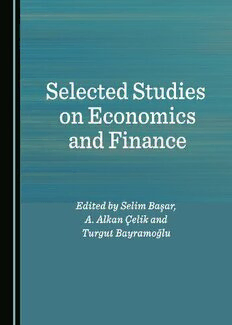Table Of ContentSelected Studies
on Economics
and Finance
Selected Studies
on Economics
and Finance
Edited by
Selim Başar, A. Alkan Çelik
and Turgut Bayramoğlu
Selected Studies on Economics and Finance
Edited by Selim Başar, A. Alkan Çelik and Turgut Bayramoğlu
This book first published 2018
Cambridge Scholars Publishing
Lady Stephenson Library, Newcastle upon Tyne, NE6 2PA, UK
British Library Cataloguing in Publication Data
A catalogue record for this book is available from the British Library
Copyright © 2018 by Selim Başar, A. Alkan Çelik, Turgut Bayramoğlu
and contributors
All rights for this book reserved. No part of this book may be reproduced,
stored in a retrieval system, or transmitted, in any form or by any means,
electronic, mechanical, photocopying, recording or otherwise, without
the prior permission of the copyright owner.
ISBN (10): 1-5275-1143-X
ISBN (13): 978-1-5275-1143-9
TABLE OF CONTENTS
List of Tables ............................................................................................ viii
List of Illustrations ...................................................................................... x
Preface ....................................................................................................... xii
1929 The Global Crisis of The Latest Poor ................................................. 1
Nazl(cid:2) Tekman
Evaluation of Post-Crisis Consolidation Through Schumpeter’s
Innovative and Entrepreneur Approach ..................................................... 12
Kübra Karaku(cid:250) & Zeliha Tekin
Poverty ....................................................................................................... 27
Eda Bozkurt & Serkan Künü
Inflation in Turkey ..................................................................................... 36
Serhat Alpa(cid:247)ut
Inflation Targeting Regime and Country Experiences .............................. 50
Murat Akda(cid:247) & Gürkan Bozma
Institutional Economics ............................................................................. 57
Murat Eren
Industry 4.0 Opportunities in Economic Development for Developing
Countries ................................................................................................... 70
Füsun Çelebi Boz
Estimation of the Effects of Turkish Labor Productivity Determinants:
A Neuro Fuzzy Approach .......................................................................... 92
Hakan Pabuçcu & Atakan Durmaz
vi Table of Contents
A Study of the Indian Metal Sector Using Time Series Decomposition-
Based Approach ....................................................................................... 105
Jaydip Sen
On Theoretical Bases of Collective Action in Regional Development .... 153
Sertaç Hopo(cid:247)lu & Serkan Künü
Global Energy Policies ............................................................................ 171
Sevim Akgül
The Energy Politics of Turkey ................................................................. 183
Selda Çak(cid:2)c(cid:2) Özk(cid:2)lbaç
The Macroeconomic Effects of Increase in Imported Crude Oil Prices .. 193
(cid:249)aduman Y(cid:2)ld(cid:2)z
Agriculture and Economic Development ................................................ 211
Dilek (cid:249)ahin
B(cid:2)ofuel and Agricultural Commodity Prices ........................................... 224
Gürkan Bozma & Murat Akda(cid:247)
Transportation Mode Selection Framework for Apparel Industries:
A Fuzzy AHP Approach .......................................................................... 234
Syed Mithun Ali, Golam Kabir, Ahammad Ali, Shahalam Shake
& Abdul Moktadir
Understanding the Global Financial Inclusion ........................................ 255
Recep Yorulmaz, Turgut Bayramo(cid:247)lu & Atakan Durmaz
Training and Development Programs as Support of Corporate
Strategy Development ............................................................................. 265
Selva Staub
Statistical Sampling Methods in Accounting Audit................................. 282
Fatma Temelli & Ömer Ç(cid:2)nar
The Importance of Strategic Cost Management in a Globalized
World ....................................................................................................... 295
Aliriza A(cid:247)
Selected Studies on Economics and Finance vii
Fx Regimes, Fx Policies and Fx Risks: Emerging Markets
Perspective ............................................................................................... 306
Deniz Parlak
Some Trends that Affect Investor Decisions in Terms of Behavioural
Finance .................................................................................................... 326
Eda Ayvac(cid:2)k
Contributors ............................................................................................. 344
LIST OF TABLES
Table 1-1. Global Crises .............................................................................. 8
Table 2-1. Structural Reforms and Regulations Made Within Transition
to the Strong Economy Program .......................................................... 16
Table 7-1. Degrees of Digitization and Integration of the Companies
(%) ....................................................................................................... 78
Table 7-2. The Investments that the Companies Plan to Make ................. 79
Table 7-3. Skills to Gain ............................................................................ 80
Table 7-4. The Share of High-Technology Product Exports in Total
Exports in the Selected Countries (%) ................................................. 82
Table 7-5. Share of Research and Development Expenditures in Gross
Domestic Product in Selected Countries (%) ....................................... 85
Table 8-1. ANFIS Structure and Parameters ............................................. 98
Table 9-1. Time Series Index Values of the Indian Metal Sector and Its
Components ....................................................................................... 113
Table 9-2. Computation Results Using Method I .................................... 119
Table 9-3. Computation Results Using Method II ................................... 122
Table 9-4. Computation Results Using Method III ................................. 124
Table 9-5. Computation Results Using Method IV ................................. 128
Table 9-6. Computation Results Using Method V................................... 136
Table 9-7. Computation Results Using Method VI ................................. 139
Table 9-8. Comparison of the Performance of the Six Forecasting
Methods ............................................................................................. 142
Table 11-1. The Shares of Resources in Energy Production (2014) ........ 173
Table 11-2. Primary Resource Consumed in the World (MTEP) ............ 174
Table 12-1. Primary Energy Production and Consumption ..................... 186
Table 12-2. Turkey's Potential for Renewable Energy Sources ............... 190
Table 13-1. Quantiles of Energy Sources in 2016's World Energy
Production .......................................................................................... 195
Table 13-2. Quantiles of Energy Sources in 2016's World Energy
Production .......................................................................................... 196
Table 16-1. Linguistic Variables and Fuzzy Scales ................................. 238
Table 16-2. Pairwise Comparison Matrix With Respect To Goal ........... 247
Table 16-3. Overall Synthesized Weighted Scores for Transportation
Mode Selection .................................................................................. 248
Selected Studies on Economics and Finance ix
Table 16-4. Sensitivity Analysis Results for Transportation Mode
Selection ............................................................................................ 251
Table 20-1. Porter’s Generic Strategies Matrix ....................................... 300
Table 20-2. Differences in Cost Management Due to Strategic
Choices .............................................................................................. 302
Table 20-3. Structural and Executional Drivers ...................................... 303
Table 21-1. Interest Rate Differentials .................................................... 318

